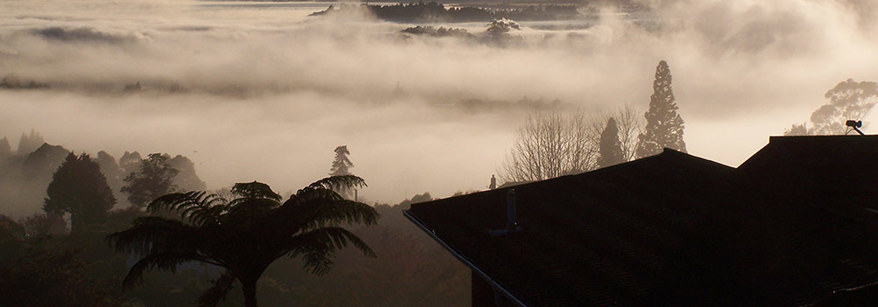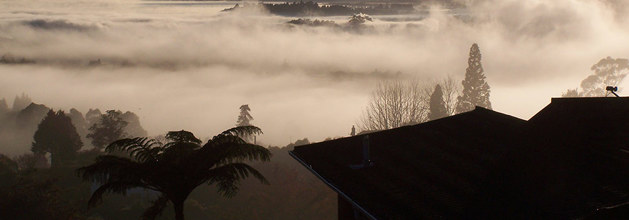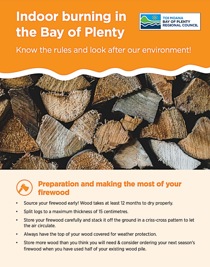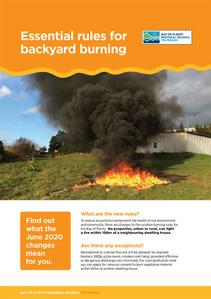Discharging contaminants into the air affects air quality in the Bay of Plenty.
Contaminants are discharged into air both from natural sources and as a result of human activity. Natural sources of contaminants into air include volcanoes, other areas of geothermal activity, pollen, wind-blown dust, sea spray and organic breakdown.
The Regional Air Plan aims to protect and improve this region’s air quality by setting rules for those who discharge contaminants into the air.
What’s in the air?
In 2023 Council updated their emission inventories for the Mount Maunganui Airshed, Rotorua, and Whakatāne, as well as an overall Region-wide inventory. These were all completed by an external air quality specialist, in accordance with best practice guidelines.
Emission sources identified include domestic heating, motor vehicles, outdoor burning, shipping and port activities, aviation, rail, industrial and commercial activities. Natural source contributions (for example sea salt and soil) were not included in the inventories.
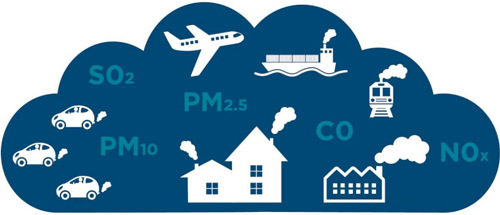
Emission inventories are not required by legislation but are a useful tool to assist with managing airsheds, by helping to determine what the main sources of air pollution are and whether they are changing over time. The inventories are a high-level “desktop” type assessment, but they are still a foundational piece of the puzzle to help Council understand the relative breakdown of emissions in a particular area. They don’t go into any discussion or detail on monitoring results, source apportionment (figuring out the exact contribution from each activity), or any other site-specific details that may contribute more or reduce the expected amounts of emissions, as this is beyond the scope of an inventory.
The inventories are one of the information inputs for future modelling work across the region, which will help us keep improving air quality in the Bay of Plenty.
Reports
- Tauranga Air Emission Inventory 2018
- Mount Maunganui Emission Inventory 2022
- Rotorua Emission Inventory 2022
- Whakatāne Emission Inventory 2022
- Regional Emission Inventory 2022
Contact the pollution hotline if you have any problems with air pollution - 0800 884 883.
Household fire
All home fires pollute the air. However an efficient, low-emission wood burner used correctly generates more heat and less smoke.
To get the best out of your fire:
- Use dry wood. This gives more heat and causes less pollution.
- Buy your firewood before winter. Store it so that air can circulate freely away from the rain.
- Start your fire with kindling. Add big pieces of wood once there is a good bed of embers.
- After starting a fire leave the air controls open for at least 30 minutes to help the wood burn well and build up a good temperature.
- Never burn rubbish, treated or painted timber as they release toxic chemicals.
- Leave the air controls on your wood burner open overnight to give out more heat rather than letting your fire smoulder. This keeps your home warmer and generates less smoke.
- Check the smoke coming out of your chimney. A clear emission usually means an efficient fire and less pollution.
Open burnings
What do the new 2020 outdoor burning rules mean for you?
To reduce air pollution and protect the health of our environment and community, there are changes to the outdoor burning rules for the Bay of Plenty. No properties, urban or rural, can light a fire within 100 metres of a neighbouring dwelling house. However, cultural and some recreational fires will still be allowed, for example, hangi, braziers, BBQs, pizza ovens, and smokers, all provided offensive or dangerous discharges are minimised. For rural production land, you can apply for resource consent to burn vegetative material within 100m of another dwelling house. These new rules were confirmed through the Environment Court on 10 June 2020, under Plan Change 13 to the Regional Air Plan.
Why are these rules important?
The burning of materials like plastics, rubber, chemicals and household rubbish is prohibited by the Regional Natural Resources Plan because there is a high risk of releasing harmful particles. These contaminants may cause serious health effects in people and animals, such as cancers, respiratory disease and birth defects.
How can I get a rural fire permit?
Fire and Emergency New Zealand issue fire permits. Please note that this is separate to resource consents issued by Regional Council. In some cases you may need both a permit and consent, or be issued a permit but not comply with Regional Council rules, so you will need to check this before lighting a fire.
If you want to light an open air fire at your rural property that complies with the 100m rule, you need to find out what the current fire season is and whether you need a fire permit. Please visit the Fire and Emergency New Zealand website for more information on fire permits and seasons, www.checkitsalright.nz.
No matter what the fire season is and whether you have a permit, you still need to follow any Council bylaws and Regional Council requirements relating to smoke nuisance and the burning of prohibited materials.
Please download the Essential Backyard Burning Rules factsheet for more details and a printable version of this information.
Vehicle emissions
What's so bad about exhaust fumes?
There are many different causes of air pollution in New Zealand with the majority being vehicle emissions and industrial emissions. The major contributor, by far, of air pollution problems comes from the transport sector - motor vehicles. In New Zealand road traffic causes 46 percent of carbon dioxide emissions. Each litre of petrol used produces 2.5 kilograms of carbon dioxide, along with carbon monoxide, nitrogen oxides, hydrocarbons, particulates and lead.
Of the four main air pollutants emitted globally, motor vehicles produce:
- 90% of all carbon monoxide in the atmosphere
- 45% of all hydrocarbons
- 50% of all nitrogen oxides
- 35% of carbon dioxide.
What's so bad about those particulates?
The particulates are so small they can penetrate deep into the lungs causing increased hospital stays, impaired lung function, increased absence from work and increased death from heart disease and lung cancer. Children, the elderly, smokers, asthmatics and others suffering from respiratory disorders are especially vulnerable to this type of air pollution.
Vehicles and Small Internal Combustion Sources
The discharge of contaminants into air from normal combustion associated with vehicles and small internal combustion sources including but not limited to chainsaws, lawnmowers and boats is a permitted activity provided the following condition is complied with:
a. The discharge must not result in excessive smoke for periods of 10 seconds or more.
Advising the vehicle owner of the problems and providing information to assist the owner on how to reduce emissions is all Bay of Plenty Regional Council will be doing at the moment. However, if the problems persist Bay of Plenty Regional Council will review its position and could introduce infringement notices.
Reducing emissions
Diesel vehicle maintenance tips
Excessive exhaust smoke can indicate engine problems. Here are some useful tips to keep your vehicle well maintained:
- Clean or change your air filter at regularly specified intervals. Diesel powered vehicles require more air intake than petrol vehicles. A clogged air intake, such as a dirty air filter, will increase smoke.
- Change the engine oil at least as often as recommended by the vehicle manufacturer. Dirty engine oil becomes very thick and will cause excessive engine and turbocharger wear leading to increased smoke emissions.
- Maintain the engine's fuel injection system, as recommended by the manufacturer. This includes:
- following recommended fuel filter change intervals
- regularly draining the water/fuel separator
- having injectors checked and cleaned to prevent plugging and replacing them when worn
- having the fuel injection pump maintained as needed.
An exhaust emission test is an easy way of checking whether your car is meeting recommended exhaust emission standards. A qualified mechanic can advise you how emissions from your vehicle can be reduced.
Petrol vehicle maintenance tips
Excessive exhaust smoke can indicate engine problems. Here are some useful tips to keep your vehicle well maintained:
- Change the engine oil at least as often as recommended by the vehicle manufacturer. Dirty engine oil becomes very thick and will cause excessive engine and turbocharger wear leading to increased smoke emissions.
- Maintain the engine's fuel system, as recommended by the manufacturer. This includes:
- following recommended fuel filter change intervals
- regularly draining the water/fuel separator
- having injectors or carburettor checked and cleaned to prevent plugging and replacing them when worn
- having the fuel injection pump maintained as needed.
- Maintain the engine (including pistons and rings) to prevent the engine burning oil.
- An exhaust emission test is an easy way of checking whether your car is meeting recommended exhaust emission standards. A qualified mechanic can advise you how emissions from your vehicle can be reduced.
Driving tips
- You can reduce excessive smoking from your vehicle by following these driving tips:
- Avoid prolonged wide-open-throttle accelerations from stops. Use moderate accelerations.
- Avoid slowing the engine down in top gear by moving into a lower gear. Doing so will prevent your engine from labouring at low rpms.
Back off the accelerator under load conditions such as when climbing hills or towing a heavy load. The fuel delivered at near maximum throttle positions, under load conditions is simply making smoke, not power.

